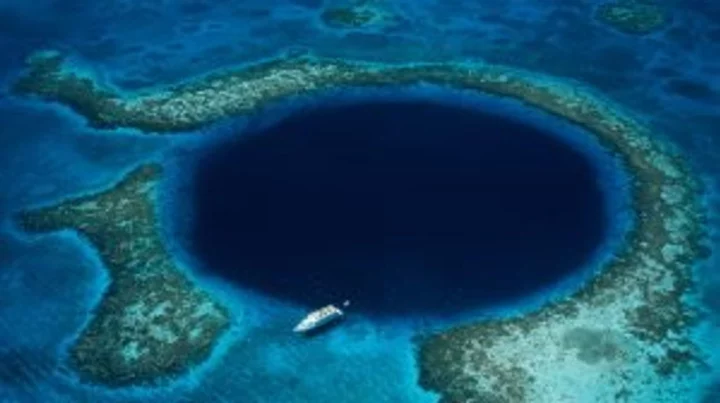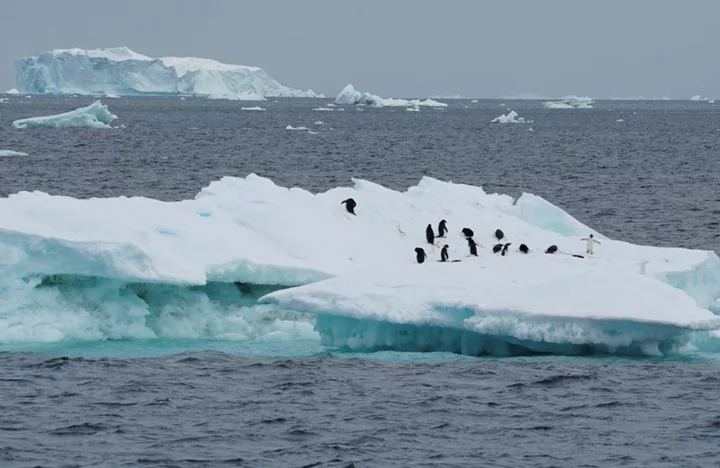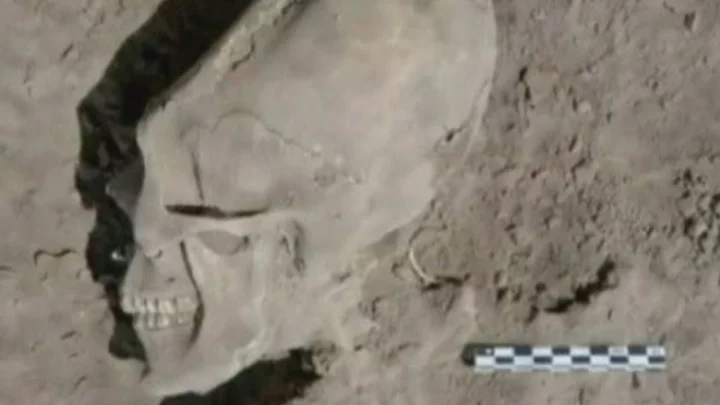
Jonnie Irwin shares emotional milestone with son Rex amid terminal cancer diagnosis
Jonnie Irwin has shared an emotional milestone as he cycled with his four-year-old son Rex, on what appeared to be Rex’s last day at nursery. The TV presenter, 49, who is best known for hosting property show A Place in the Sun and Escape to the Country, publicly revealed his diagnosis in November 2022 after his lung cancer spread to his brain. He has previously said he “doesn’t know how long” he has to live. Irwin, who has been receiving palliative care for the past three years, posted an update on Monday (8 August) as he accompanied Rex on his way to nursery. “Last EVER ride to nursery with Rex,” wrote Irwin in a new Instagram post, sharing a series of pictures of himself and Rex on their bicycles as Irwin’s two-year-old son, Rafa, played with a spade. “Suitably waved off by Rafa and his spade and Rex with his game face on!” added Irwin. Irwin, who shares his three boys Rex and twins Rafa and Cormac with his wife Jessica Holmes, detailed his experience of palliative hospice care in a recent interview with BBC Morning Live. The property expert described his hospice experience as a “delight”, adding that his initial perception of such facilities were that they were “very much a boiling hot room full of people who looked frail and towards the end of their days”. However, it was “nothing of the sort” when he did actually go in. “It’s spacious, energised, comfortable,” Irwin told the show, adding: “I’ve had a really, really good experience at my hospice.” He urged anyone who is facing a terminal diagnosis to “embrace” end-of-life care and to try going to a hospice if they have been offered the choice. “My first experience of palliative care and hospice was blood transfusions,” he explained. “I had my first blood transfusion in hospital and then was invited to use the hospice, so I have it a go as a day patient and went into a lovely room. “I implore people to check out hospices. If you’ve got the choice of using it, then use it… I encourage people to explore that option because it’s not the doom and gloom operation you might think it was.” Irwin recently revealed that sometimes he has to “remove himself” from his family home to go to a hospice when he is in a lot of pain because it makes him “not good to be around”. He told Hello! magazine: “I’m like a bear with a sore head and I don’t want [my family] to be around that.” In another appearance with podcast OneChat previously, he said that being in pain affects his mood, explaining: “I have been close to death’s door, twice at least. You lose your memory, you lose your patience. I have got a very short temper. It’s not made me a better person, that’s for sure.” Read More King’s Guard shares sweet exchange with young boy wearing royal uniform ‘Oblivious’ woman defended after walking through beach wedding: ‘They don’t own the beach’ Sandra Bullock’s sister praises actor for being an ‘amazing caretaker’ to late partner Bryan Randall What is ALS and what are the causes? Brain’s appetite control centre different in overweight or obese people – study Areas with lower bird diversity ‘have more mental health hospital admissions’
2023-08-08 17:27

What is ALS and what are the causes?
Sandra Bullock’s longterm partner Bryan Randall has died at the age of 57 after a three-year battle with amyotrophic lateral sclerosis (ASL). His family shared a statement confirming that Randall “passed away peacefully” on Saturday (5 August), adding that he “chose early to keep his journey with ALS private and those of us who cared for him did our best to honour his request”. The statement, sent to People magzine, continued: “We are immensely grateful to the tireless doctors who navigated the landscape of this illness with us and to the astounding nurses who became our roommates, often sacrificing their own families to be with ours.” Bullock and Randall first met in 2015 and made their first public appearance together the following year. The model-turned-photographer’s family has asked for donations to be made to the ALS Association and the Massachusetts General Hospital. ALS affects nerve cells in the brain and spinal cord, its name coming from the Greek and referring to a wasting away of the muscles responsible for controlling voluntary movement caused by a lack of nourishment, the fault of a genetic mutation. As the ALS Association explains: “Motor neurons reach from the brain to the spinal cord and from the spinal cord to the muscles throughout the body. The progressive degeneration of the motor neurons in ALS eventually leads to their demise. “When the motor neurons die, the ability of the brain to initiate and control muscle movement is lost. When voluntary muscle action is progressively affected, people may lose the ability to speak, eat, move and breathe. “The motor nerves affected when you have ALS are the motor neurons that provide voluntary movements and muscle control. Examples of voluntary movements are making the effort to reach for a smartphone or step off a curb. These actions are controlled by the muscles in the arms and legs.” Early symptoms of the disease, according to the US National Institute of Neurological Disorders and Strokes (NINDS), include: muscle twitches in the arm, leg, shoulder or tongue; cramps; tight or stiff muscles; muscle weakness; slurred or nasal speech; and difficulty chewing and swallowing. “The first sign of ALS usually appears in the hand or arm and can show as difficulty with simple tasks such as buttoning a shirt, writing, or turning a key in a lock,” the NINDS explains. “In other cases, symptoms initially affect one leg. People experience awkwardness when walking or running, or they may trip or stumble more often.” There is currently no cure for ALS but the US Food and Drug Administration has approved four drugs to treat the condition and ease the discomfort of sufferers: Riluzole, Nuedexta, Radicava and Tiglutik. It was first discovered by French neurologist Jean-Martin Charcot in 1869 and is also commonly known as Lou Gehrig’s disease in memory of the celebrated New York Yankees baseman (1903-41) who also suffered from it. While ALS affects all demographics, it is most common among people aged between 55 and 75 and, according to some studies, disproportionately affects former members of the armed forces, perhaps because of exposure to harmful toxins during their service careers although this has not been definitively substantiated. The ALS Association reports that, in 90 per cent of cases of ALS, there is no family history of the genetic mutation that causes the disease and, in the 5-10 per cent of cases in which there is, only a 50 per cent possibility exists of its being passed on. For more information, please visit the websites of the ALS Association or the National Institute of Neurological Disorders and Strokes. Read More Roberta Flack announces she has ALS and finds it ‘impossible to sing’ NIH to fund unproven ALS drugs under patient-backed law ALS drug wins FDA approval despite questionable data Brain’s appetite control centre different in overweight or obese people – study Areas with lower bird diversity ‘have more mental health hospital admissions’ Greg Rutherford rushed to hospital ‘screaming and clawing at his skin’
2023-08-08 17:19

Scientists make disturbing discovery at the bottom of Belize's Giant Blue Hole
The ocean is home to all manner of mysteries, from “alien” shape-shifters to ancient shipwrecks. And so, when Richard Branson and a team of scientists took a submersible down to the bottom of Belize’s iconic Giant Blue Hole, they were braced for some truly extraordinary sights. The Blue Hole is the largest sinkhole in the world, measuring 300m (984 feet) across and around 125m (410 feet) deep but, until Branson’s expedition in 2018 its depths had not been fully explored. The British billionaire was joined on his groundbreaking journey by Fabien Cousteau – the grandson of pioneering underwater explorer Jacques Cousteau – and oceanographer Erika Bergman. Sign up for our free Indy100 weekly newsletter Their mission was to create a 3D map of the hole’s interior but, when they reached the bottom, they were met by some disturbing discoveries. To be fair, they got off to a good start. The first thing they encountered as they edged down the hole was a wall of giant stalactites, which were “breathtakingly beautiful,” according to Branson. Then, at around 300 feet, they pierced a thick layer of toxic hydrogen sulphide, plunging them into darkness and cutting out the oxygen from the water around them. In an interview with CNN, Bergman explained that once you pierce that layer, which forms naturally over centuries, “you lose all of that Caribbean sunlight and it just turns completely black.” Elsewhere, Branson described it as “extremely eerie,” saying: “We didn’t expect to see any creatures below. But when we got to the bottom we could see crabs, conches and other creatures that had fallen into the hole, arrived on the bottom and then ran out of oxygen and died.” As the team continued to travel further down into the abyss, they were faced with the remains of a tragedy. In an interview with Business Insider back in July 2020, Bergman revealed that they found the bodies of two people who have “been lost in the Blue Hole”. “We found the resting place of a couple [of] folks,” she said. “And we just sort of very respectfully let the Belize government know where we found them.” She added that “everyone decided that we would just not attempt any recovery”, noting: “It's very dark and peaceful down there, [so we] just kind of let them stay.” As they reached the bottom, the team found something else unexpected, and very much unwelcome: human rubbish. It came in the form of a 2-litre Coke bottle and a lost GoPro containing some holiday snaps, according to Business Insider. “As for the mythical monsters of the deep? Well, the real monsters facing the ocean are climate change – and plastic,” Branson lamented following the discovery. “Sadly, we saw plastic bottles at the bottom of the hole, which is a real scourge of the ocean.” The business magnate said the expedition had offered “one of the starkest reminders of the danger of climate change [he had] ever seen.” He pointed out: “The Blue Hole is made of a complex system of caves that once formed on dry land. It is proof of how oceans can rise quickly and catastrophically. “Sea levels were once hundreds of feet lower. 10,000 years ago the sea level rose by about 300 feet when a lot of ice melted around the world. At 300 feet down you could see the change in the rock where it used to be land and turned into sea.” He added in his blog: “Hopefully by this trip taking place we have raised even more awareness of the need to protect the ocean and tackle climate change now – before it is too late.” He stressed that he didn’t want his grandchildren to “grow up in a world without corals, without the wonders of the ocean”. Have your say in our news democracy. Click the upvote icon at the top of the page to help raise this article through the indy100 rankings.
2023-08-08 17:17

No quick fix to reverse Antarctic sea ice loss as warming intensifies - scientists
By David Stanway SINGAPORE Sea ice in the Antarctic region has fallen to a record low this year
2023-08-08 16:55

Areas with lower bird diversity ‘have more mental health hospital admissions’
Areas with lower bird diversity appear to have a higher number of hospital admissions related to mental health conditions, research suggests. Experts analysed data from ebird – an online database of bird observations by citizen scientists – to estimate diversity across the US state of Michigan. The team then combined this with hospital admissions for anxiety and mood disorders in the state. The findings, published in the journal Geo: Geography And Environment, showed lower bird diversity to be a significant predictor of higher numbers of hospital admissions for mental health conditions, highlighting the complex relationship between the disorders and biodiversity crises. It is critical we take a holistic approach to our mental health and nature Dr Rachel Buxton The researchers said that while income and the presence of green spaces were the strongest predictors of anxiety and mood disorder-related admissions, there were also independent “significant associations” between mental health and bird diversity. Lead author Dr Rachel Buxton, assistant professor at the Institute of Environmental and Interdisciplinary Sciences at Carleton University in Canada, said: “Often we consider nature as representing the amount of green space near homes or the distance to the nearest park, but the link between species diversity and health is underexplored. “Our study shows that if species diversity can affect mental health at the severe end of the spectrum (hospitalisations), it is possible that the decline in biodiversity across the globe may be intricately connected with our anxiety and mood on a day-to-day basis. “It is critical we take a holistic approach to our mental health and nature. “Investing in nature should not be viewed as a luxury, but a necessity, and evaluated in the context of the support for wellbeing it offers individuals and communities living in urban or nature-scarce environments. “Restoring and conserving diverse bird communities could be one avenue to improving mental health in cities and factored into urban restoration projects and public health policies.” Last year, researchers from King’s College London found that watching birds or listening to birdsong was linked to mental wellbeing, with effects lasting up to eight hours. The Institute of Psychiatry, Psychology & Neuroscience (IoPPN) team said at that time that the links between birds and mental wellbeing were not explained by co-occurring environmental factors such as the presence of trees, plants or waterways.
2023-08-08 16:19

Brain’s appetite control centre different in overweight or obese people – study
The brain’s appetite control centre is different in the brains of people who are overweight or live with obesity, a new study suggests. The researchers said their findings add further evidence to the relevance of brain structure to weight and food consumption. Current estimates suggest that more than 1.9 billion people worldwide are either overweight or obese. And, according to the Office for Health Improvement and Disparities, almost two-thirds of adults in the UK are overweight or living with obesity. This increases the risk of developing health issues like type 2 diabetes, heart disease and stroke, cancer and poorer mental health. The last two decades have given us important insights about appetite control and how it may be altered in obesity Professor Paul Fletcher, University of Cambridge A number of factors influence how much people eat and what they eat, including genetics, hormone regulation, and the environment they live in, researchers say. However, it is not entirely clear what happens to the brain to tell us that we are hungry or full. Past studies have shown that the hypothalamus – a small region of the brain about the size of an almond – plays an important role. Dr Stephanie Brown, from the Department of Psychiatry and Lucy Cavendish College, University of Cambridge, said: “Although we know the hypothalamus is important for determining how much we eat, we actually have very little direct information about this brain region in living humans. “That’s because it is very small and hard to make out on traditional MRI brain scans.” Professor Paul Fletcher, the study’s senior author, from the Department of Psychiatry and Clare College, Cambridge, said: “The last two decades have given us important insights about appetite control and how it may be altered in obesity. “Metabolic researchers at Cambridge have played a leading role in this. “Our hope is that, by taking this new approach to analysing brain scans in large datasets, we can further extend this work into humans, ultimately relating these subtle structural brain findings to changes in appetite and eating and generating a more comprehensive understanding of obesity.” The majority of evidence for the role of the hypothalamus in appetite regulation comes from animal studies, which indicate complex interacting pathways within the hypothalamus, with different cell populations acting together to tell us when we are hungry or full. To get around this researchers used an algorithm developed using machine learning to analyse brain scans taken from 1,351 young adults across a range of BMI scores. They looked for differences in the hypothalamus when comparing individuals who are underweight, healthy weight, overweight, or living with obesity. According to the findings, the overall volume of the hypothalamus was significantly larger in the overweight and obese groups of young adults. The researchers describe a significant relationship between volume of the hypothalamus and body mass index (BMI). The differences were most apparent in those sub-regions of the hypothalamus that control appetite through the release of hormones to balance hunger and fullness. While the exact significance of the finding is unclear, one explanation is that the change relates to inflammation, the researchers suggest. Eating a high-fat diet could trigger inflammation of our appetite control centre Dr Stephanie Brown, University of Cambridge Previous animal studies have shown that a high-fat diet can cause inflammation of the hypothalamus, which in turn prompts insulin resistance and obesity. In mice, just three days of a fat-rich diet is enough to cause this inflammation. Other studies have shown that this inflammation can raise the threshold at which animals are full – in other words, they have to eat more food than usual to feel full. Dr Brown added: “If what we see in mice is the case in people, then eating a high-fat diet could trigger inflammation of our appetite control centre. “Over time, this would change our ability to tell when we’ve eaten enough and to how our body processes blood sugar, leading us to put on weight.” More research is needed to confirm whether increased volume in the hypothalamus is a result of being overweight or whether people with larger hypothalami are predisposed to eat more in the first place. It is also possible that these two factors interact with each other, causing a feedback loop, the study published in Neuroimage: Clinical, and supported by the Bernard Wolfe Health Neuroscience Fund, Wellcome and the NIHR Cambridge Biomedical Research Centre, with additional funding from Alzheimer’s Research UK, suggests.
2023-08-08 16:15

The Sherlocks feel like 'the Tyson Fury of the music industry'
Sheffield rockers The Sherlocks have described themselves as the "Tyson Fury of the music industry" after their fight to the top.
2023-08-08 15:15

US court blocks Biden debt relief rule benefiting defrauded students
By Nate Raymond (Reuters) -A federal appeals court on Monday blocked the Biden administration from proceeding with another piece of
2023-08-08 09:49

Scientists discover skull that has never been seen before
Scientists have discovered an ancient skull in China, like no other they've seen before. The 300,000-year-old child skull was first discovered in Hualongdong back in 2019 alongside other fossil remains. The Chinese Academy of Sciences (CAS) have struggled to match them to a known lineage. The discovery left researchers baffled as it did not resemble Neanderthals or Denisovans, according to Science Alert. It led them to believe we are either missing a branch from the human family tree or need to add to it. While the skull had similarities to early modern humans, there is a lack of chin and was likened to an extinct species of human in Asia known as a Denisovan. This shape has "never been recorded in late Middle Pleistocene hominin fossil assemblages in East Asia," scientists said in a recent analysis. They believe the remains, known in the science world as HDL 6, could possibly be a combination of modern human and unknown hominin that existed in China, according to the outlet. Sign up for our free Indy100 weekly newsletter In other scientific news, archaeologists are too afraid to open the tomb of Qin Shu Huang, who ruled from 221 BC to 210 BC. The tomb is guarded by a terracotta army of soldiers and horses and was found by farmers back in 1974 in the Shaanxi province of China. Not only do archaeologists believe it will cause damage, but there are rumours of deathly booby traps that could kill curious intruders, according to IFL Science. Writings by Chinese historian Sima Qian 100 years after Qin Shu Huang's death claim "Palaces and scenic towers for a hundred officials were constructed and the tomb was filled with rare artifacts and wonderful treasure." He continued: "Craftsmen were ordered to make crossbows and arrows primed to shoot at anyone who enters the tomb. Mercury was used to simulate the hundred rivers, the Yangtze and Yellow River, and the great sea, and set to flow mechanically." Have your say in our news democracy. Click the upvote icon at the top of the page to help raise this article through the indy100 rankings.
2023-08-08 00:23

Coronavirus: Can your dog or cat get Covid-19 and can you catch it from your pet?
In February a pet dog in Hong Kong tested ‘weak positive‘ for coronavirus and was placed into quarantine. The Agriculture, Fisheries and Conservation Department (AFCD) in Hong Kong confirmed that repeated tests suggested the dog had a “low-level” of the virus and that it was likely to be the case of human-to-animal transmission. The dog, a Pomeranian, had not shown any symptoms for the illness but its owner was confirmed as being infected with Covid-19. Now pet owners are becoming increasingly concerned they could catch the deadly disease from their animals - but is that scientifically possible? Can I catch coronavirus from my pet? On 2 April a Chinese study showed that cats are "highly susceptible" to coronavirus and it can easily be passed between them. But only five cats were involved in the experiment. This follows the news that a cat reportedly contracted coronavirus in Belgium but health authorities in the country said it was an "isolated case" and not "the rule". There are still no reports of animals in the UK with coronavirus. On 13 March the World Health Organisation said "at present there is no evidence that companion animals/pets such as dogs or cats can be infected with the new coronavirus". Several global health organisations have issued advisories saying there is no any evidence that pet animals can spread coronavirus or indeed be infected with it in the same way as humans. “Therefore, there is no justification in taking measures against companion animals which may compromise their welfare,” the World Organisation for Animal Health has said. The Centers for Disease Control and Prevention concurred that “there is no reason to think that any animals including pets in the United States might be a source of infection with this new coronavirus”. Raymond R.R. Rowland, a veterinarian who specialises in swine viruses at Kansas State University, said that “weak positives” frequently show up in testing pigs, where a farmer’s livelihood can be at stake. “I’ll tell you what I tell them,” he told The New York Times. “Wait and see.” Even if the Pomeranian has a low-level infection, he said: “that doesn’t say the animal is sufficiently infected that it can spread the virus.” The dog could simply be a host for the illness that neither becomes unwell or infects other people or animals. Should I change my behaviour with my pet? The World Health Organisation says: "It is always a good idea to wash your hands with soap and water after contact with pets. “This protects you against various common bacteria such as E.coli and Salmonella that can pass between pets and humans.” To protect yourself from catching coronavirus, the WHO advises the following: Cover your mouth and nose while sneezing, with a tissue or your elbow Put the tissue straight into a closed bin Wash your hands afterwards, and then frequently, with soap or sanitiser Keep your distance from people who are coughing and sneezing (at least one metre) [[Updated UK government advice also says people should stay at home and practice social distancing]. You can read more about the WHO’s advice on coronavirus here. Read More What are symptoms of coronavirus – and where has it spread? Latest travel updates as coronavirus continues to spread Can face masks really protect you against coronavirus or flu? The dirty truth about washing your hands Greg Rutherford had mystery allergy left him ‘screaming and clawing at his skin’ What is Lyme disease? Bella Hadid reveals ’15 years of invisible suffering’ Study reveals how muscle cells deteriorate with age, hampering injury recovery
2023-08-07 23:54

Accenture Completes Acquisition of Anser Advisory
NEW YORK & SANTA ANA, Calif.--(BUSINESS WIRE)--Aug 7, 2023--
2023-08-07 23:23

Ne-Yo apologizes for comments about parents of trans kids
Ne-Yo has apologized for remarks he made about gender identity and parenting trans children.
2023-08-07 23:18
